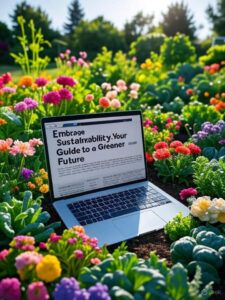How to Start a Sustainable Garden
Creating a sustainable garden is an excellent way to grow your own food, support local wildlife, and minimize environmental impact. By focusing on eco-friendly practices, resource conservation, and biodiversity, you can build a thriving garden that benefits both you and the planet. This article outlines practical steps to start a sustainable garden, optimized for long-term success and search engine visibility.

What Is a Sustainable Garden?
A sustainable garden works in harmony with nature, using methods that conserve water, enrich soil, and support local ecosystems. Unlike conventional gardening, which may rely on chemical fertilizers and pesticides, sustainable gardening emphasizes organic practices, renewable resources, and minimal waste. By following these principles, you can create a garden that’s productive, resilient, and environmentally friendly.
Step 1: Plan Your Garden with Sustainability in Mind
Before digging in, plan your garden to align with sustainable principles. Consider your climate, soil type, and available space to choose plants that thrive naturally in your area.
- Choose Native and Climate-Appropriate Plants: Native plants are adapted to your region’s climate and soil, requiring less water and maintenance. For example, in arid regions, opt for drought-tolerant plants like lavender or succulents. Research your USDA Hardiness Zone to select suitable species.
- Assess Your Space: Whether you have a large backyard or a small balcony, tailor your garden to fit. Raised beds, vertical gardens, or container gardening work well for small spaces.
- Set Goals: Decide if you want to grow vegetables, herbs, flowers, or a mix. Prioritize plants that serve multiple purposes, like edible flowers (e.g., nasturtiums) or plants that attract pollinators.
Internal Link: Learn more about selecting the right plants for your region in our guide on choosing native plants for your garden.
Step 2: Build Healthy Soil Organically
Healthy soil is the foundation of a sustainable garden. Instead of relying on synthetic fertilizers, focus on natural methods to enrich your soil.
- Compost: Create a compost bin to recycle kitchen scraps (vegetable peels, coffee grounds) and yard waste (leaves, grass clippings). Composting reduces landfill waste and provides nutrient-rich material for your garden.
- Use Organic Mulch: Apply mulch like wood chips, straw, or shredded leaves to retain soil moisture, suppress weeds, and improve soil structure.
- Test Your Soil: Conduct a soil test to understand its pH and nutrient levels. Amend soil with organic matter like compost or aged manure to correct deficiencies.
Internal Link: Discover how to create your own compost in our detailed article on composting for beginners.
Step 3: Conserve Water with Smart Practices
Water conservation is critical for sustainable gardening, especially in areas prone to drought. Implement these strategies to minimize water use:
- Install a Rain Barrel: Collect rainwater to irrigate your garden, reducing reliance on municipal water.
- Drip Irrigation or Soaker Hoses: These systems deliver water directly to plant roots, minimizing evaporation and runoff.
- Water Wisely: Water early in the morning or late in the evening to reduce evaporation. Group plants with similar water needs together to optimize irrigation.
Internal Link: Explore water-saving techniques in our post on efficient garden irrigation methods.
Step 4: Promote Biodiversity
A sustainable garden supports local wildlife and pollinators, which are essential for plant reproduction and ecosystem health.
- Plant Pollinator-Friendly Species: Include flowers like bee balm, coneflowers, or sunflowers to attract bees, butterflies, and other pollinators.
- Create Habitats: Add birdhouses, bat boxes, or insect hotels to encourage beneficial wildlife. Avoid removing dead wood or leaves, as they provide shelter for insects.
- Companion Planting: Pair plants that benefit each other, such as marigolds with tomatoes to deter pests naturally.
Internal Link: Read our guide on companion planting for pest control to enhance your garden’s resilience.
Step 5: Manage Pests and Weeds Naturally
Avoid chemical pesticides and herbicides, which can harm beneficial insects and soil health. Instead, use organic pest and weed control methods.
- Natural Pest Repellents: Introduce beneficial insects like ladybugs or use neem oil to manage pests. Plant garlic or onions to repel aphids.
- Hand-Pull Weeds: Remove weeds manually or use mulch to suppress their growth. Vinegar-based solutions can also target weeds without harming the environment.
- Crop Rotation: Rotate crops annually to prevent pest buildup and maintain soil fertility.
Internal Link: Learn more about organic pest control in our article on natural pest management for gardens.
Step 6: Choose Sustainable Materials and Tools
Select eco-friendly materials and tools to reduce your garden’s environmental impact.
- Repurpose Materials: Use reclaimed wood for raised beds or recycled containers for planting.
- Invest in Durable Tools: Choose high-quality, long-lasting tools to minimize waste. Opt for manual tools like hand trowels over gas-powered equipment.
- Avoid Single-Use Plastics: Use biodegradable pots or reusable trays instead of plastic ones.
Step 7: Maintain and Monitor Your Garden
Sustainability requires ongoing care. Regularly monitor your garden to ensure it remains healthy and productive.
- Keep a Garden Journal: Track planting dates, harvest yields, and pest issues to learn what works best.
- Update Practices: Refresh mulch, add compost annually, and adjust watering based on seasonal changes.
- Engage the Community: Share seeds, cuttings, or produce with neighbors to foster a local gardening network.
Internal Link: Check out our tips on maintaining a sustainable garden year-round for long-term success.
Conclusion
Starting a sustainable garden is a fulfilling journey that benefits your health, wallet, and the environment. By planning thoughtfully, enriching soil organically, conserving water, promoting biodiversity, and using eco-friendly materials, you can create a thriving garden that aligns with sustainable principles. Follow the steps outlined above, and leverage SEO strategies to share your knowledge with a wider audience. Happy gardening!
Internal Link: Ready to expand your garden? Explore our guide on advanced sustainable gardening techniques for more tips.
BSE 12th Result 2025: How to Check, Toppers List, and Key Updates

